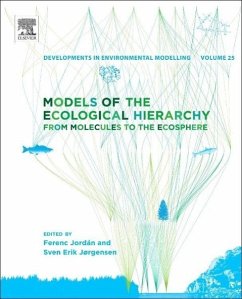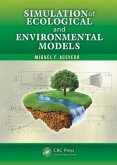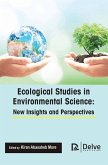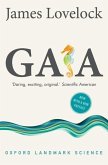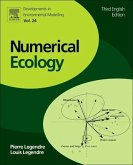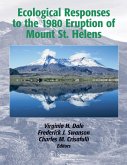Models of the Ecological Hierarchy
From Molecules to the Ecosphere Volume 25
Herausgegeben:Jordan, Ferenc; Jorgensen, Sven Erik
Schade – dieser Artikel ist leider ausverkauft. Sobald wir wissen, ob und wann der Artikel wieder verfügbar ist, informieren wir Sie an dieser Stelle.
Models of the Ecological Hierarchy
From Molecules to the Ecosphere Volume 25
Herausgegeben:Jordan, Ferenc; Jorgensen, Sven Erik
- Gebundenes Buch
- Merkliste
- Auf die Merkliste
- Bewerten Bewerten
- Teilen
- Produkt teilen
- Produkterinnerung
- Produkterinnerung
In the application of statistics to ecological inference problems, hierarchical models combine explicit models of ecological system structure or dynamics with models of how ecological systems are observed. The principles of hierarchical modeling are applied in this book to a wide range of problems ranging from the molecular level, through populations, ecosystems, landscapes, networks, through to the global ecosphere.
Provides an excellent introduction to modelling Collects together in one source a wide range of modelling techniques Covers a wide range of topics, from the molecular level to the global ecosphere…mehr
Andere Kunden interessierten sich auch für
![Simulation of Ecological and Environmental Models Simulation of Ecological and Environmental Models]() Miguel F AcevedoSimulation of Ecological and Environmental Models146,99 €
Miguel F AcevedoSimulation of Ecological and Environmental Models146,99 €![Ecological Studies in Environmental Science: New Insights and Perspectives Ecological Studies in Environmental Science: New Insights and Perspectives]() Ecological Studies in Environmental Science: New Insights and Perspectives175,99 €
Ecological Studies in Environmental Science: New Insights and Perspectives175,99 €![Silent Spring Silent Spring]() Rachel CarsonSilent Spring9,99 €
Rachel CarsonSilent Spring9,99 €![Gaia Gaia]() James LovelockGaia10,99 €
James LovelockGaia10,99 €![Being Ecological Being Ecological]() Timothy MortonBeing Ecological9,99 €
Timothy MortonBeing Ecological9,99 €![Numerical Ecology Numerical Ecology]() Pierre LegendreNumerical Ecology99,50 €
Pierre LegendreNumerical Ecology99,50 €![Ecological Responses to the 1980 Eruption of Mount St. Helens Ecological Responses to the 1980 Eruption of Mount St. Helens]() Virginia H. Dale / Frederick J. Swanson / Charles M. Crisafulli (eds.)Ecological Responses to the 1980 Eruption of Mount St. Helens44,99 €
Virginia H. Dale / Frederick J. Swanson / Charles M. Crisafulli (eds.)Ecological Responses to the 1980 Eruption of Mount St. Helens44,99 €
In the application of statistics to ecological inference problems, hierarchical models combine explicit models of ecological system structure or dynamics with models of how ecological systems are observed. The principles of hierarchical modeling are applied in this book to a wide range of problems ranging from the molecular level, through populations, ecosystems, landscapes, networks, through to the global ecosphere.
Provides an excellent introduction to modelling Collects together in one source a wide range of modelling techniques Covers a wide range of topics, from the molecular level to the global ecosphere
Provides an excellent introduction to modelling Collects together in one source a wide range of modelling techniques Covers a wide range of topics, from the molecular level to the global ecosphere
Produktdetails
- Produktdetails
- Developments in Environmental Modelling 25
- Verlag: Elsevier / Elsevier Books
- Artikelnr. des Verlages: 35153963
- Seitenzahl: 594
- Erscheinungstermin: 29. November 2012
- Englisch
- Abmessung: 239mm x 193mm x 28mm
- Gewicht: 1384g
- ISBN-13: 9780444593962
- ISBN-10: 0444593969
- Artikelnr.: 36138454
- Herstellerkennzeichnung
- Libri GmbH
- Europaallee 1
- 36244 Bad Hersfeld
- gpsr@libri.de
- Developments in Environmental Modelling 25
- Verlag: Elsevier / Elsevier Books
- Artikelnr. des Verlages: 35153963
- Seitenzahl: 594
- Erscheinungstermin: 29. November 2012
- Englisch
- Abmessung: 239mm x 193mm x 28mm
- Gewicht: 1384g
- ISBN-13: 9780444593962
- ISBN-10: 0444593969
- Artikelnr.: 36138454
- Herstellerkennzeichnung
- Libri GmbH
- Europaallee 1
- 36244 Bad Hersfeld
- gpsr@libri.de
Quantum chemical modeling in the molecular ecology; Cooperative molecules in the origin of life; Dealing with spatial autocorrelation in gene flow modeling; A virtual model for analyzing toxicity in cell-based assays; "Keystone species" of the molecular network of cellular functions; Evolutionary transition to complex population dynamic patterns in a population with age structure; The maximum sustainable yield management of an age-structured salmon population; The influence of hydrodynamic processes on zooplankton transport and distributions in the north western Mediterranean sea estimated from a lagrangian model. Application to Pelagia noctiluca; Use of tracking system data for individual-based modeling of sweet fish (Plecoglossus altivelis) behavior; A mechanistic individual-based model of Oïkopleura dioïca; Modeling of processes of interspecific competition in the stand; Dynamic modes in a discrete two-sex age-structured three-component population model; Application of information theory models in the early detection of plant community degradation and prediction of vegetation changes; Body size determines community structure and dynamics; Modelling the Venice lagoon food web: a backcasting experiment; Trophic Network Analysis: Assessing the System-Wide Properties of Pastoral Ecosystems; Modeling interaction structure for food web with parasites; Dynamic Residence Time Analysis for Ecological Networks; Food web structure and trophic interactions of a tropical highland lake, Ethiopia; Modeling plant effects on salt marsh mercury cycling; Developing a model for the mercury cycle in the Marano-Grado Lagoon; Differentiating between the impact of global climate drivers and local anthropogenic pressures on the ecology of a mid-size South-Alpine lake; Modeling biogeochemical carbon dioxide and nutrient cycles in the North Sea with a 1D ERSEM Model; Comparative study of the cycling of mangrove litter nitrogen to the adjacent estuary through modeling in pristine and reclaimed islands of Sundarban mangrove ecosystem, India; ACQUANET and QUAL2K in water water quality control of the Nadela system in Serbia; Cities as Ecosystems: functional simlarity of simple analogy?; Three dimensional modeling of pollutant dispersion in Lake Garda (Northern Italy); DLES: a framewok for integrated modelling of forest ecosystems; Modelling of carbon cycling from mangrove litter to the adjacent Hooghly - Matla estuarine system, India; Modeling the effects of landscape changes caused by high altitude ski-pistes on bird species richness and distribution in the Alps; Forest coverage changes in Protected Areas: A fine-scale Markov chain approach Development of program tool for determination of potential of landscape visual exposure; Open Source spatial algorithms applied to landscape genetics; Biodiversity conservation in dynamic landscapes: compensation of habitat patch destruction by habitat recreation; Combining habitat suitability models and fluvial functionality data for a multilayer assessment of riverine vulnerability; The worst scenario principle and the assessment of the impact of quality of life for biosphere dynamics; Carbon cycle modeling and principle of the worst scenario; Modeling and evaluating the energy flow in the global ecosystems and its impacts on human ecological footprint
Quantum chemical modeling in the molecular ecology; Cooperative molecules in the origin of life; Dealing with spatial autocorrelation in gene flow modeling; A virtual model for analyzing toxicity in cell-based assays; "Keystone species" of the molecular network of cellular functions; Evolutionary transition to complex population dynamic patterns in a population with age structure; The maximum sustainable yield management of an age-structured salmon population; The influence of hydrodynamic processes on zooplankton transport and distributions in the north western Mediterranean sea estimated from a lagrangian model. Application to Pelagia noctiluca; Use of tracking system data for individual-based modeling of sweet fish (Plecoglossus altivelis) behavior; A mechanistic individual-based model of Oïkopleura dioïca; Modeling of processes of interspecific competition in the stand; Dynamic modes in a discrete two-sex age-structured three-component population model; Application of information theory models in the early detection of plant community degradation and prediction of vegetation changes; Body size determines community structure and dynamics; Modelling the Venice lagoon food web: a backcasting experiment; Trophic Network Analysis: Assessing the System-Wide Properties of Pastoral Ecosystems; Modeling interaction structure for food web with parasites; Dynamic Residence Time Analysis for Ecological Networks; Food web structure and trophic interactions of a tropical highland lake, Ethiopia; Modeling plant effects on salt marsh mercury cycling; Developing a model for the mercury cycle in the Marano-Grado Lagoon; Differentiating between the impact of global climate drivers and local anthropogenic pressures on the ecology of a mid-size South-Alpine lake; Modeling biogeochemical carbon dioxide and nutrient cycles in the North Sea with a 1D ERSEM Model; Comparative study of the cycling of mangrove litter nitrogen to the adjacent estuary through modeling in pristine and reclaimed islands of Sundarban mangrove ecosystem, India; ACQUANET and QUAL2K in water water quality control of the Nadela system in Serbia; Cities as Ecosystems: functional simlarity of simple analogy?; Three dimensional modeling of pollutant dispersion in Lake Garda (Northern Italy); DLES: a framewok for integrated modelling of forest ecosystems; Modelling of carbon cycling from mangrove litter to the adjacent Hooghly - Matla estuarine system, India; Modeling the effects of landscape changes caused by high altitude ski-pistes on bird species richness and distribution in the Alps; Forest coverage changes in Protected Areas: A fine-scale Markov chain approach Development of program tool for determination of potential of landscape visual exposure; Open Source spatial algorithms applied to landscape genetics; Biodiversity conservation in dynamic landscapes: compensation of habitat patch destruction by habitat recreation; Combining habitat suitability models and fluvial functionality data for a multilayer assessment of riverine vulnerability; The worst scenario principle and the assessment of the impact of quality of life for biosphere dynamics; Carbon cycle modeling and principle of the worst scenario; Modeling and evaluating the energy flow in the global ecosystems and its impacts on human ecological footprint

